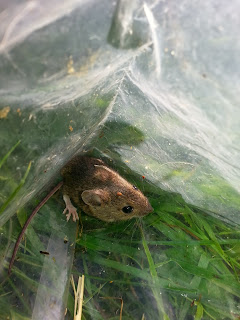It was forecast for rain, and it did. Those of us optimistic
– or daft - enough to think it worthwhile going in sat around in the shed,
drank coffee and chatted. It was forecast to clear by mid-morning, and it did,
but by now the ground was far too wet to rake grass on the steep bank above the
Octagon Pond or do any of the other jobs planned. Increasing light encouraged
an attempt at photographing falling leaves and the changing colours of autumn.
The only other wildlife on display was a mini-crocodile of schoolchildren
arriving at the Chapel.
 |
| After the rain |
Over the summer months, we bloggers worked on the West Wood
wildlife survey; others tended allotments in Gibside’s walled garden, mowed
grass along The Avenue, around the Chapel and other places, or did useful jobs
around the estate. Come Wednesday of the first week in October though, the
Conservation Volunteer Team regrouped for a season of toil aimed at improving
the wilder bits of Gibside for wildlife.
 |
| Building logpiles in the rain |
 |
| Orange Peel Fungus (Aleuria aurantia) |
It rained that day as well. In building the raised walkway
from the new car park, trees had been felled or cut back. Logs and brash, piled
up to rot down, make an attractive home for fungi, invertebrates, amphibians
and small mammals; they, in turn, attract other wildlife. It was hard but
satisfyingly constructive work – and, on this occasion, wet.
 |
| Autumn arrives on The Avenue |
The following week we were back to the never ending task of
pulling out saplings of the invasive, non-native Western Hemlock in Snipes
Dene. Again, we were rained off. There’s a pattern developing here. And there’s
still the grass to rake.
 |
| Western Hemlock |
 |
| Coffee Break before the rain came |
 |
| Emerging Fly Agaric |
Steve Wootten & Phil Coyne














